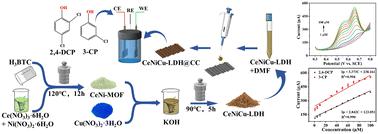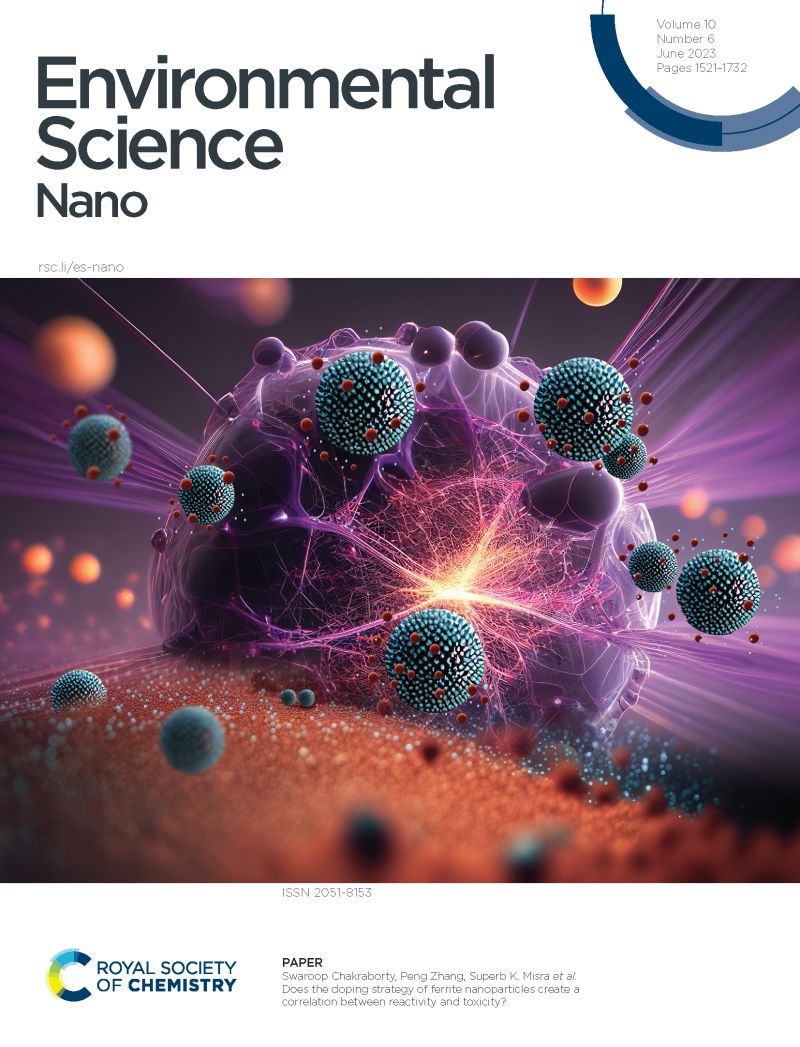A novel electrochemical sensor for simultaneous determination of 2,4-dichlorophenol and 3-chlorophenol
IF 5.8
2区 环境科学与生态学
Q1 CHEMISTRY, MULTIDISCIPLINARY
引用次数: 0
Abstract
Electrochemical sensors have garnered considerable interest from researchers due to their ability to quickly and accurately detect chlorophenols, which are widespread environmental pollutants with significant health risks. This study presents a novel hydrophilic carbon cloth electrode modified with Ce/Ni/Cu layered double hydroxide (CeNiCu-LDH@CC) for detecting endocrine disruptors 2,4-dichlorophenol (2,4-DCP) and 3-chlorophenol (3-CP). Using a Ce/Ni metal–organic framework (CeNi-MOF) as a precursor, the material is doped with Cu(II) and then alkali-etched into LDH. This process enhances the adsorption sites and surface area of the material, resulting in an electrochemically active surface area (ECSA) of 9.68 cm2 for CeNiCu-LDH@CC. The electrochemical tests reveal that Cu(II) doping improves the conductivity of the sensor, enhancing its performance for chlorophenol detection. The sensor detects 2,4-DCP and 3-CP simultaneously with a linear range of 1 to 100 μM and detection limits of 0.197 μM and 0.286 μM, respectively. Moreover, the CeNiCu-LDH@CC sensor demonstrates high recovery rates in real sample tests, indicating its practical application potential. In summary, the CeNiCu-LDH@CC sensor developed in this study shows exceptional sensing capabilities, stability, and selectivity for 2,4-DCP and 3-CP, making it suitable for simultaneous detection of these compounds.

一种同时测定 2,4-二氯苯酚和 3-氯苯酚的新型电化学传感器
电化学传感器能够快速准确地检测氯酚,因此引起了研究人员的极大兴趣。本研究介绍了一种用 Ce/Ni/Cu 层状双氢氧化物(CeNiCu-LDH@CC)修饰的新型亲水性碳布电极,用于检测内分泌干扰物 2,4-二氯苯酚(2,4-DCP)和 3-氯苯酚(3-CP)。以 Ce/Ni 金属有机框架(CeNi-MOF)为前体,在材料中掺入 Cu(II),然后碱蚀到 LDH 中。这一过程增强了材料的吸附位点和表面积,使 CeNiCu-LDH@CC 的电化学活性表面积(ECSA)达到 9.68 平方厘米。电化学测试表明,掺杂 Cu(II) 提高了传感器的电导率,增强了其检测氯苯酚的性能。该传感器可同时检测 2,4-DCP 和 3-CP,线性范围为 1 至 100 μM,检测限分别为 0.197 μM 和 0.286 μM。此外,CeNiCu-LDH@CC 传感器在实际样品测试中表现出很高的回收率,表明其具有实际应用潜力。总之,本研究开发的 CeNiCu-LDH@CC 传感器对 2,4-DCP 和 3-CP 具有卓越的传感能力、稳定性和选择性,因此适合同时检测这两种化合物。
本文章由计算机程序翻译,如有差异,请以英文原文为准。
求助全文
约1分钟内获得全文
求助全文
来源期刊

Environmental Science: Nano
CHEMISTRY, MULTIDISCIPLINARY-ENVIRONMENTAL SCIENCES
CiteScore
12.20
自引率
5.50%
发文量
290
审稿时长
2.1 months
期刊介绍:
Environmental Science: Nano serves as a comprehensive and high-impact peer-reviewed source of information on the design and demonstration of engineered nanomaterials for environment-based applications. It also covers the interactions between engineered, natural, and incidental nanomaterials with biological and environmental systems. This scope includes, but is not limited to, the following topic areas:
Novel nanomaterial-based applications for water, air, soil, food, and energy sustainability
Nanomaterial interactions with biological systems and nanotoxicology
Environmental fate, reactivity, and transformations of nanoscale materials
Nanoscale processes in the environment
Sustainable nanotechnology including rational nanomaterial design, life cycle assessment, risk/benefit analysis
 求助内容:
求助内容: 应助结果提醒方式:
应助结果提醒方式:


